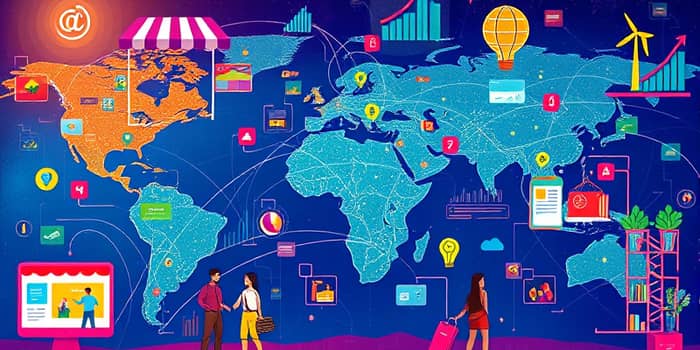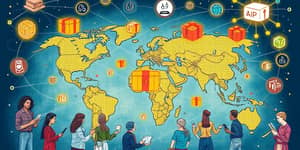Building a thriving online enterprise demands more than ambition; it requires a clear vision, careful planning, and the ability to grow without sacrificing efficiency or ethics. In an era where consumer expectations, technology, and environmental imperatives evolve rapidly, businesses must embrace strategies that drive revenue while safeguarding long-term resilience.
Foundations for Sustainable Scaling
Defining your business model and niche is the critical first step. A scalable model—whether e-commerce, SaaS, or digital services—must accommodate growth in customers and transactions without linear cost increases. Equally important is selecting a focused niche: case studies show that pivoting to eco-friendly pet products led to a 35% revenue increase within months.
To solidify your roadmap, establish SMART goals that guide each quarter. Specific, Measurable, Achievable, Relevant, and Time-bound objectives help teams stay aligned and allow for timely course corrections. Regular progress reviews, even on a biweekly basis, ensure strategies evolve in step with market trends and operational realities.
- Analyze customer behavior with Google Analytics or Mixpanel
- Create detailed personas to inform marketing and development
- Ensure product-market fit through iterative feedback loops
Expanding Your Market Reach
Content marketing and SEO remain cornerstones of organic growth. High-value, evergreen content fuels ongoing traffic, while timely pieces on breakthroughs—like AI-driven marketing in 2025—generate immediate buzz. Blend both to capture new audiences and retain search ranking momentum.
Technical SEO cannot be overlooked: optimize page speed, mobile responsiveness, and crawlability to maximize visibility. Meanwhile, platform diversification broadens engagement and sales channels. For B2C brands, Instagram and TikTok enable shoppable posts and user-generated content, yielding a 28% boost in audience participation. In B2B or SaaS, LinkedIn fosters thought leadership and direct outreach.
Consider internationalization as your brand matures. Translating your platform and tailoring messaging to local preferences unlocks fresh revenue streams. Automated email marketing sequences and targeted marketplace listings can further amplify reach across borders.
Optimizing Operations for Growth
Operational excellence separates thriving enterprises from those that stagnate. Implement automation in customer support, marketing workflows, and order fulfillment to reduce manual errors and free up human capital for strategic tasks. Integrate CRM systems and AI-driven personalization tools to deliver consistent, high-quality customer experiences at scale.
Data-driven decision making is non-negotiable. A/B test campaigns relentlessly; in one study, LinkedIn ad variations focusing on cost-efficiency outperformed productivity-oriented ads by 22%. Leverage dashboards that consolidate KPIs—conversion rates, average order value, churn metrics—so you can pivot tactics within days, not quarters.
- Deploy chatbots and automated ticketing for 24/7 support
- Use predictive analytics to forecast demand and inventory
- Establish cross-selling and upselling workflows
Fostering Customer Loyalty and Lifetime Value
Acquiring new customers is costly; boosting retention yields higher returns. Loyalty programs, personalized rewards, and exclusive offers can lift repeat purchases by up to 15%. Nurture relationships via segmented email campaigns that deliver recommendations based on browsing and purchase history.
True personalization hinges on activating customer data responsibly. Integrate purchase patterns, engagement signals, and preferences to tailor experiences. Brands that master this see conversion rates rise by double digits and create ambassadors who drive word-of-mouth growth.
Embedding Sustainability and ESG Principles
Consumers and investors are increasingly drawn to brands that demonstrate environmental and social responsibility. A staggering 73% of global consumers are willing to change habits to support sustainable businesses. Meanwhile, 88% of enterprises view sustainability as a core long-term value driver.
Operationalizing ESG involves setting clear targets, reporting transparently, and designing circular supply chains. For instance, companies integrating renewable energy and waste reduction protocols are 1.4 times more likely to unlock innovation breakthroughs. By 2030, nature-positive supply chains could generate $4.5 trillion in economic value.
Innovating and Future-Proofing Your Enterprise
Stagnation is the enemy of growth. Embrace cutting-edge technologies—AI-powered analytics, chatbots, and green energy solutions—to optimize costs and differentiate your brand. Strategic partnerships, whether with sustainability experts or technology providers, can provide access to resources and new markets.
Adopting agile management frameworks empowers teams to pivot swiftly. Short sprints, regular retrospectives, and cross-functional collaboration foster a culture of continuous improvement and rapid innovation.
Measuring Success and Navigating Challenges
Robust measurement frameworks tie every initiative back to core KPIs. Track not only financial metrics—revenue growth, average order value, conversion rates—but also ESG indicators such as carbon footprint, water usage, and renewable energy adoption. Companies that balance profit with purpose demonstrate resilience in volatile markets.
Common barriers include over-reliance on a single channel, underinvestment in data infrastructure, and superficial sustainability efforts. Overcome these by diversifying revenue streams—digital courses, subscriptions, consulting—and embedding transparency in your reporting.
Looking Ahead: Trends and Recommendations
The convergence of sustainability and digital innovation will dictate winners in the coming decade. Businesses that verify ESG credentials and harness AI-driven insights will capture market share and investor confidence. By 2030, enterprises combining these strengths can expect significant economic advantages and heightened brand loyalty.
Begin by auditing your current operations against sustainability benchmarks, then prioritize automation and data integration. Establish partnerships that amplify your capabilities, and maintain an agile mindset to pivot as technologies and consumer expectations evolve. With these strategies, your online enterprise will be poised for sustained, responsible growth in the digital age.
References
- https://gentryandstone.com/2025/04/26/proven-strategies-to-scale-your-online-business-in-2025/
- https://www.weforum.org/stories/2025/01/unlocking-sustainability-green-growth-innovative-strategies/
- https://growth-grid.ai/blog/unlocking-potential-top-business-growth-strategies-for-sustainable-success/
- https://www.venasolutions.com/blog/esg-statistics
- https://www.ecorn.agency/blog/e-commerce-growth-strategies
- https://time.com/collection/worlds-best-companies-sustainable-growth-2025/
- https://myvirtualcoo.com/growth-strategies-for-business-setting-the-stage-for-sustainable-success-in-2025/
- https://www.arbor.eco/blog/sustainability-statistics
- https://accountabilitynow.net/growth-in-business-2025/
- https://www.keyesg.com/article/50-esg-statistics-you-need-to-know
- https://onlinemba.ku.edu/mba-blog/business-growth-strategies
- https://thesustainableagency.com/blog/sustainability-facts-and-statistics-for-business-owners/
- https://www.growlio.io/blog/small-business-growth-strategies
- https://www.myaifrontdesk.com/blogs/9-proven-small-business-growth-strategies-for-2025
- https://r.statista.com/en/licensing/worlds-best-companies-sustainable-growth-2025/award/
- https://www.erm.com/insights/2025-annual-trends-report-the-path-forward-for-sustainable-business/










